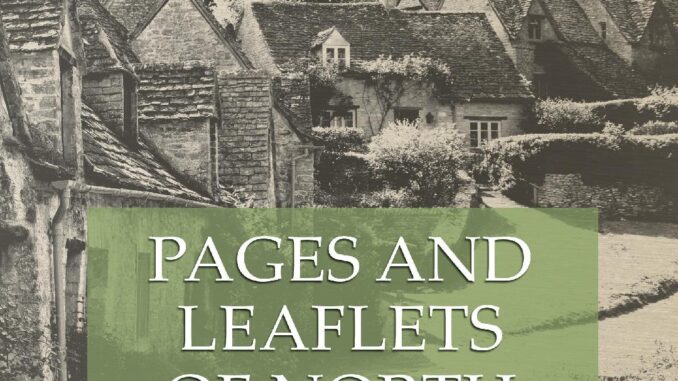
What is your story? Everyone has one. With the popularity of websites and television shows tracing ancestry roots more and more people have become interested in tracing their family history, DNA, and genealogy. Exploring deep into the past can bring us surprises in who we think we are. We might even find secrets through are family histories. Angela Fortnum through patience, persistence went on an extensive journey to discover her maternal lineage and family story. She shares her discovery with readers in Pages and Leaflets of North Oxfordshire. This book is a tribute to her mother Muriel Page born in 1916. Pages in the book title refers to her mother’s maiden name and Leaflets, perhaps the paper trails she chased.

Muriel Page was born at South Newington Mill in Oxfordshire County, United Kingdom. The daughter and author, Angela Fortnum was born about 60 miles from London, in Banbury, Oxfordshire County. Banbury and South Newington Mill are only about a distance of 6 miles from each other. Fortnum’s research takes her on a much further trek through her family and religious history back to the turn of the eighteenth century England.

Fortnum begins her journey with a discussion of the origins of the name Page. This surname page is very common in England, Scotland, Ireland, and France. It is derived from the 16th century and was used to describe a young male servant. This is when people were named after their occupations before William the Conqueror standardized hereditary names. She found that the surname Page due to illiteracy had a host of spellings from Page to Paige and even Padge and other obscure spellings.

Fortnum discovers a baptismal certificate and death certificate for the son of her 8 generations back Great Grandfather (GGF), James Page, in Much Haddon. The St. Peter ad Vincula church records for James Page date from 1702. From this paper trail and a burial record for her 8-GGF in the Quakers’ Ye Meeting Yard, she surmises that this faction of the family may have been Quakers, who originally settled here in 1663.

James Page and Dorathy had six children: four boys and two girls. The interesting surprise for her was this relative was listed as a parish clerk not a Quaker. The girls Mary and Elizabeth received an inheritance from their Uncle John Rymell, probably Dorathy’s brother. Fortnum has a transcription of the will in her book. She found records for their three sons who were married in the Church of England. John Page was one of these four sons and her 5-times-GGF. He and his wife Sarah had twelve children. Sarah’s family traces back to the 1600’s. One of their son’s James was Fortnum’s 4-times-GGF.

This book includes many pictures of the various churches and chapels Fortnum was able to connect to her research and change of family religions. The family’s history coincides with the history of England from agricultural and or labor life to self-employment and business entrepreneur. I found her mother’s and her own story the most compelling since it was in person recollections. If this well-researched book inspires your own interest in family history, sociology, anthropology, and or religious conviction you might want to use this as a roadmap on how to begin your own journey to the past. Also I suggest, if you are interested in preserving your current family’s history, you visit the Chicago Cultural Center’s Story Corps. They partnered with NPR’s WBEZ 91.5 FM to preserve the voices of Chicagoans and their community. ch*****@st********.org. ch*****@st********.org.">http://ch*****@st********.org.
Photos are courtesy of Angela Fortnum

Be the first to comment